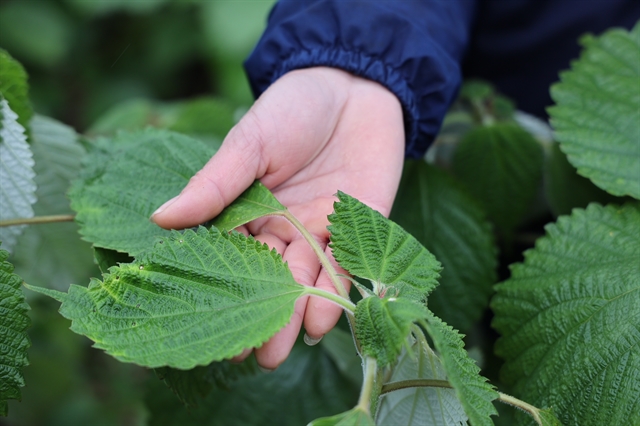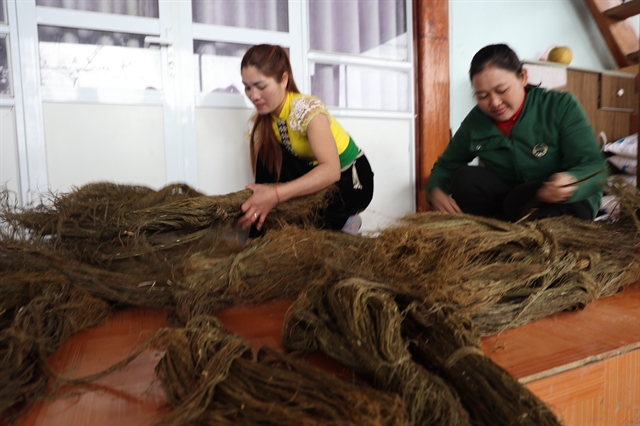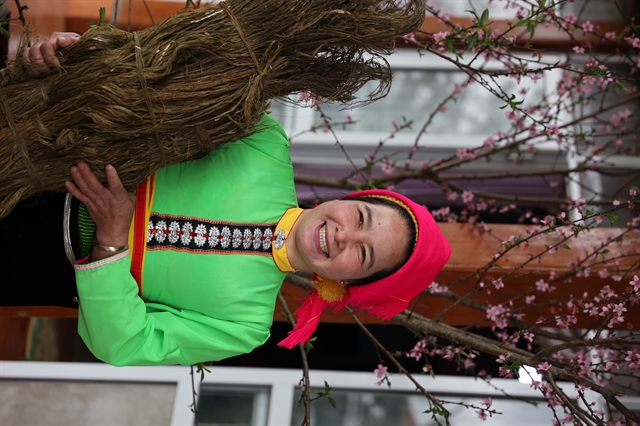Lê Hương
For the past few years, ramie (a vegetable fibre noted for its length and toughness) has gradually replaced food crops such as maize and cassava in Vân Hồ District, in the northern province of Sơn La, and the flowering plant of the nettle family has brought better incomes to local farmers.
Liên Hòa Commune, 50km from the centre of Vân Hồ, is home to Thái and Mường ethnic groups. Before planting ramie, every family in the commune planted maize and cassava for an average income of less than VNĐ20 million (US$860) per year. Most of these families were listed as poor according to national standards.

Ramie takes root easily in the locality. — VNS Photo Nguyễn Nam
Vì Văn Tuấn, deputy chairman of Liên Hòa’s People’s Committee, said the authorities, in cooperation with Vinafi Company, examined local soil and weather conditions in 2017.
They decided to plant ramie on a trial area of one hectare. Realising the plant grew well on the local land and had high value, they persuaded locals to quit other crops to focus on ramie. The company committed to signing contracts to buy dry ramie wholesale at a stable price.
“At first, we did not know much about the techniques for planting it, resulting in low yield,” said Quách Thị Tuyến, who was among the first to grow ramie. By the end of 2018, only six families had planted the herbaceous perennial in an area of four hectares.

Quách Thị Tuyến (right) and her sister take care of her family's ramie field. — VNS Photo Nguyễn Nam
In 2019 the Gender Responsive Equitable Agriculture and Tourism (GREAT) Programme, funded by the Australian Government, decided to promote women’s economic empowerment by developing a ramie production chain that would be managed by women in the commune.
GREAT partnered with Vinafi Company and Sơn La Planting & Vegetable Protection Department (of Sơn La Agriculture & Rural Development Department) to deliver the project.
GREAT, Vinafi and the department hosted various training courses for locals. As many as 13 production groups were established. Local farmers were given technical know-how to grow ramie.
“We will have a better harvest next season,” Tuyến said. “My family’s income has increased gradually. Last year we got VNĐ140 million from ramie, excluding fertiliser expenses. It can be harvested four or five times for 10 years before we need to replace the old plants.”
Tuyến said the income from the crop exceeded her family’s expectations -- and it proved to be four to six times more profitable than planting maize or cassava.
Tuyến and her husband no longer have to work far from home and have paid all their outstanding debts.
“We even upgraded our house and bought some more precious things for our family like a fridge, washing machine, and TV set,” she said.
Tuyến now spares only a small area of maize to feed her chickens.
She uses the ramie leaves to feed cows and buffalo, while the stalks can be used as biomass fuel for cooking. Ramie leaves also enrich the soil.
Local farmers also sell the dried bark, which could only gets half the price of ramie fibre.
Tuyến said the local community hopes agencies teach them to extract ramie fibre to enhance the value of the final product and get more income.

Dried ramie can be kept for a long time. — VNS Photo Nguyễn Nam
Lưu Thanh Nga, from Sơn La Planting & Vegetable Protection Department, appreciates GREAT’s support.
“GREAT has come along with us to train locals to plant ramie, expand the market, and empower women,” she said. “The programme has provided farmers with technical know-how and tools so that they can support themselves. The programme has made changes for the better in the region.”
Over 200 households (more than 900 people) are now cultivating ramie across an area of 150 hectares.
“Local living standards have been significantly enhanced,” Tuyến said. “Women are now playing an important role in various social tasks. Thanks to GREAT’s courses on gender, the local women are no longer reserved. They speak up more often in community meetings.”
Tuyến also said local production had not seriously suffered during the pandemic.
“We can keep dried ramie bark in a plastic bag for many months,” she said. “Due to social distancing, the company was slower to collect the material. But it did not matter much. The dried bark was still in good condition, waiting to be collected. The company just paid us a little bit later. We were lucky not to be affected much by the pandemic.”
Tuấn said the authorities were trying to persuade more farmers to cultivate ramie so that poverty in the area could be sustainably reduced. In 2019, when the project started its activities, there were only 70 hectares of ramie in Vân Hồ and Mộc Châu districts, but this has increased to more than 1,000 hectares as of December 2021.
Vinafi plans to start ramie planting in neighbouring districts including Mai Sơn, Phù Yên, Yên Châu and Sốp Cộp.
With the introduction of this perennial crop and strong support from the GREAT programme, life looks brighter for all the communities involved. VNS

Ramie brings stable income to locals. — VNS Photo Nguyễn Nam
OVietnam